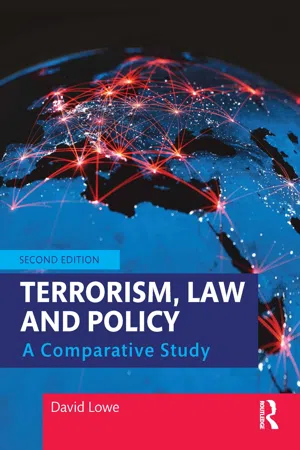
- 344 pages
- English
- ePUB (mobile friendly)
- Available on iOS & Android
About this book
Terrorism, Law and Policy: A Comparative Study is a textbook offering a comparative study of the terrorism-related legislation, policy and practice introduced from international governmental bodies such as the UN and the European Union, and individual states, with a focus on Australia, Canada, New Zealand, the UK and the US. It offers a uniquely legal perspective on key themes relating to terrorism and security.
This new edition is brought fully up to date with the ever-changing developments in terrorist activity, as well as in states' approaches to anti-terrorism legislation and policy. It includes new chapters on the far-right and extreme far-right cause, one on offering a comparative study of the anti-terrorism policies of states and international bodies, and the role of international and national counter-terrorism agencies, planning and preparing acts of terrorism and a new chapter on freedom of expression, hate crime and proscribing groups as terrorist organisations.
Terrorism, Law and Policy: A Comparative Study is ideally suited for terrorism and security modules at undergraduate and postgraduate levels, and will also be of interest to practitioners working on the legal aspects of these areas.
Frequently asked questions
- Essential is ideal for learners and professionals who enjoy exploring a wide range of subjects. Access the Essential Library with 800,000+ trusted titles and best-sellers across business, personal growth, and the humanities. Includes unlimited reading time and Standard Read Aloud voice.
- Complete: Perfect for advanced learners and researchers needing full, unrestricted access. Unlock 1.4M+ books across hundreds of subjects, including academic and specialized titles. The Complete Plan also includes advanced features like Premium Read Aloud and Research Assistant.
Please note we cannot support devices running on iOS 13 and Android 7 or earlier. Learn more about using the app.
Information
Part I
Current terrorist threats
Chapter 1 Islamist-inspired terrorist groups
Topics covered in this chapter:
- If there is a difference between old and new terrorism;
- Overview of Al Qaeda;
- Overview of Al Shabaab;
- Overview of Islamic State;
- Case study – Islamic State in Russia;
- Overview of Boko Haram and growth of Islamic State groups in Africa and Afghanistan.
At the end of this chapter you will:
- Understand how and why Al Qaeda were formed and what the group’s cause is;
- Understand how and why Al Shabaab were formed and what the group’s cause is;
- Understand how and why Islamic State were formed and what the group’s cause is;
- Assess how and why Islamist groups pose a threat to states’ security.
Introduction
Terrorism: It is not a new phenomenon brought about by Al Qaeda in 2001
The impact of 9/11 on people’s psyche
The imagery of terror is media created, since few people actually saw people leaping to their death or the collapse of the Towers. Yet it seems real and is part of a political spectacle … While the powerful and immediate imagery of the Twin Towers being hit, the people fleeing, others jumping to certain death from buildings, the exhausted fire-fighters and the Twin Lights monument opened in New York in March 2002 all suggest that what we saw was a reality, a palpable natural event.2
Origins of terrorism and examples of conflicts pre-9/11
Is there a difference between old and new terrorism?
Points for reflection
- Why is it thought that there is a difference between a perceived old and new terrorism?
- What impact has 9/11 had in the psyche of citizens in relation to terrorism?
Al Qaeda
Table of contents
- Cover
- Half-Title
- Title
- Copyright
- Dedication
- Contents
- Table of statutes
- Table of cases
- Preface
- Acknowledgements
- Introduction
- PART I Current terrorist threats
- PART II Government and international bodies anti-terrorism policies and roles of international and national counter-terrorism agencies
- PART III Legal definition of terrorism and statutory powers used in counter-terrorism investigations
- PART IV Extremism, freedom of expression, hate crime and Prevent strategies
- Bibliography
- Index